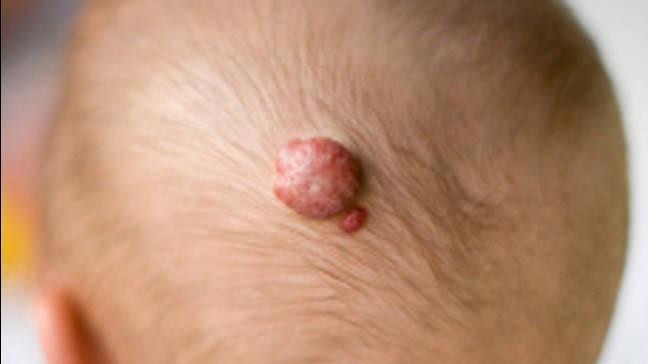HEMANGIOMA

Definition: A hemangioma is a birthmark that appears as a bright red patch or a nodule of extra blood vessels in the skin. It often grows during the first year of life and then recedes over time. A hemangioma is usually benign and isn’t associated with other medical conditions. [1]
Symptoms
A hemangioma may be present at birth or appear during the first several weeks of life. It starts out as a flat red mark anywhere on the body, most often the face, scalp or back of the neck. During the first year of life, the red mark becomes a spongy mass that protrudes from the skin — often growing rapidly up to 2 or 3 inches (about 5 to 7.5 centimeters) in diameter. The hemangioma then stops growing and enters a rest phase. Eventually, it begins to slowly disappear.
Half of all hemangiomas resolve by age 5, and nearly all hemangiomas are resolved by age 10. Although the color of the birthmark also fades faint, but permanent, discoloration of the skin or residual extra skin may remain. [1]
Types of Hemangiomas
Strawberry hemangiomas (also called strawberry mark, nevus vascularis, capillary hemangioma, hemangioma simplex) may appear anywhere on the body, but are most common on the face, scalp, back, or chest. These are the most common types of hemangloma. They consist of small, closely packed blood vessels. They may be absent at birth, and develop at several weeks. They usually grow rapidly, remain a fixed size, and then subside. In most cases, strawberry hemangiomas disappear by the time a child is 9 years old. Some slight discoloration or puckering of the skin may remain at the site of the hemangioma. [2]
Cavernous hemangiomas (also called angioma cavernosum or cavernoma) are similar to strawberry hemangiomas but are more deeply situated. They may appear as a red-blue spongy mass of tissue filled with blood. Some of these lesions may disappear on their own — usually as a child approaches school age. [2]
Port-wine stains (naevus flammeus) are flat purple-to-red birthmarks. These reddish or purplish marks on the skin are the result of malformed blood vessels that stay dilated (open) all the time. About 3 in 1,000 people are born with port–wine stains, which appear most commonly on the face and upper body. The marks tend to darken and even thicken with age. Their surface can become uneven and bumpy, and may bleed easily. These birthmarks occur most often on the face and may vary in size. Port-wine stains often are permanent (unless treated). [3]
Causes
A hemangioma consists of an abnormally dense group of extra blood vessels. It’s not clear what causes the blood vessels to group together, although some research suggests a link between hemangiomas and certain proteins produced by the placenta during pregnancy. [1]
Treatment
The majority of hemangiomas never need any form of treatment, and treatment of hemangiomas is somewhat controversial. Some parents feel that hemangioma treatment is necessary because the marks can be disfiguring and may cause social or psychological problems. Doctors, however, may be hesitant to treat a hemangioma that isn’t causing physical problems because hemangiomas usually fade gradually without treatment, and treatments have potential side effects. Treatment options may include:
- Laser surgery. Lasers can stop the growth of a hemangioma. Sometimes lasers can be used to remove a hemangioma or treat sores on a hemangioma that won’t heal. The risks are potentially serious, including pain, infection, bleeding, scarring and changes in skin color.
The exception to this is Port wine Stains. Lasers have made a huge impact on treating port–wine stains because they can destroy blood vessels near the skin without significantly damaging the skin itself. Most port–wine stains respond well to treatment with a yellow pulsed dye laser. This type of laser uses a concentrated beam of light that heats and destroys targeted blood vessels while leaving the overlying skin undamaged. [3]
- Corticosteroid medications. Corticosteroids can be injected, given by mouth or applied to the skin. These medications are most effective when they’re given during the growth phase. Sometimes long-term or repeated treatment is needed. The risks are potentially serious, including poor growth, high blood sugar, high blood pressure, and clouding of the normally clear lens of the eye (cataract).
Other treatments for red birthmarks may include:
- Cryotherapy (freezing)
- Laser surgery
- Surgical removal [2]
Because researchers want to find other treatments that are effective, with fewer side effects, research is ongoing. Some newer, though still experimental, treatments include use of beta blockers, interferon alfa and topical immune suppressants. [1]
References
- Hemangioma. The Mayo Clinic. http://www.mayoclinic.com/health/hemangioma/DS00848/DSECTION=symptoms
- http://www.webmd.com/skin-problems-and-treatments/guide/red-birthmarks
- Port Wine Stains. Dr. Brian Zelickson. http://www.zelskin.com/yc_birthmarks.html


